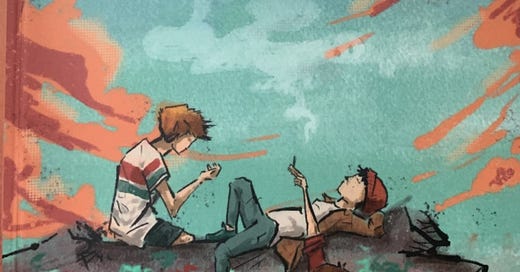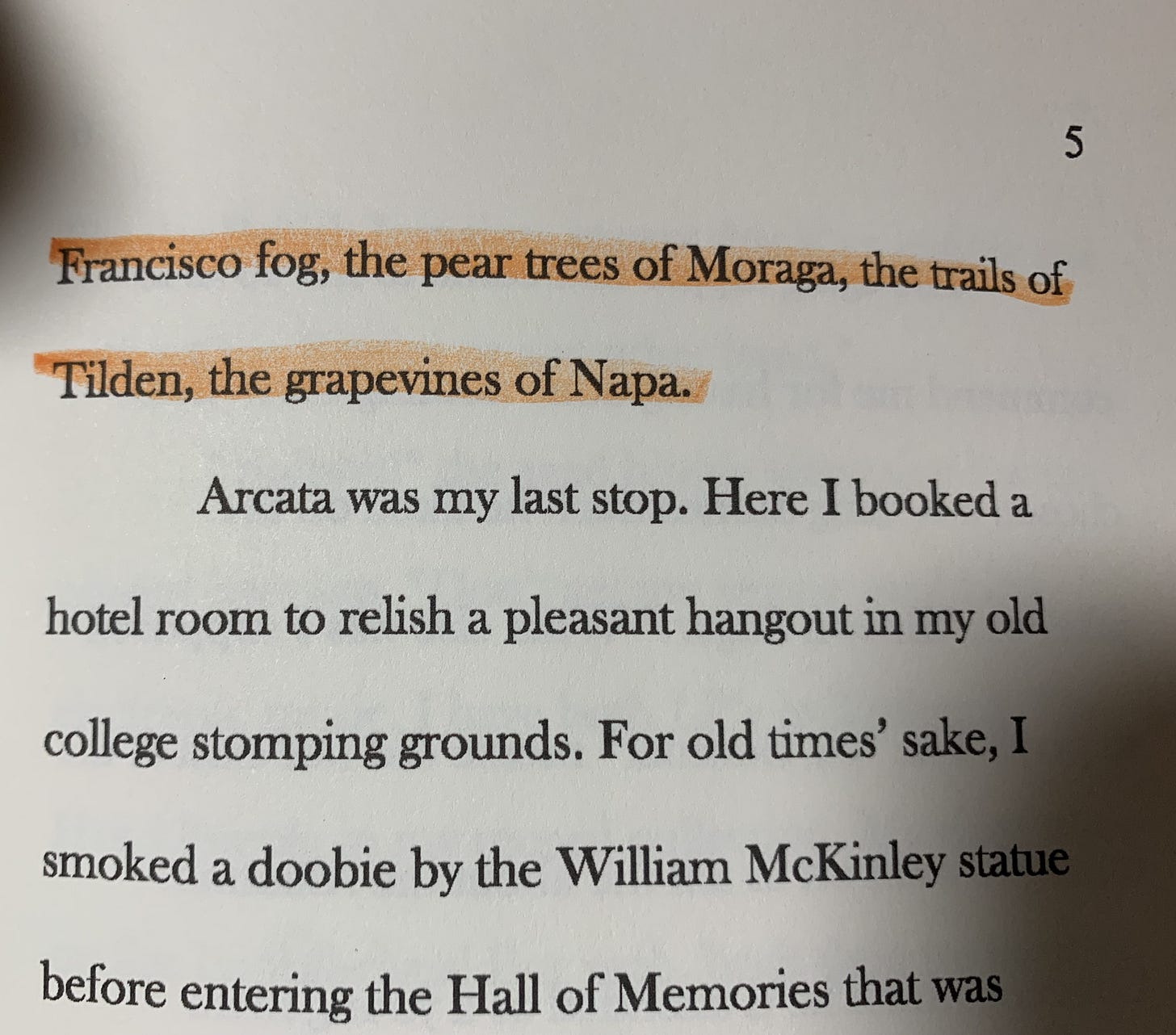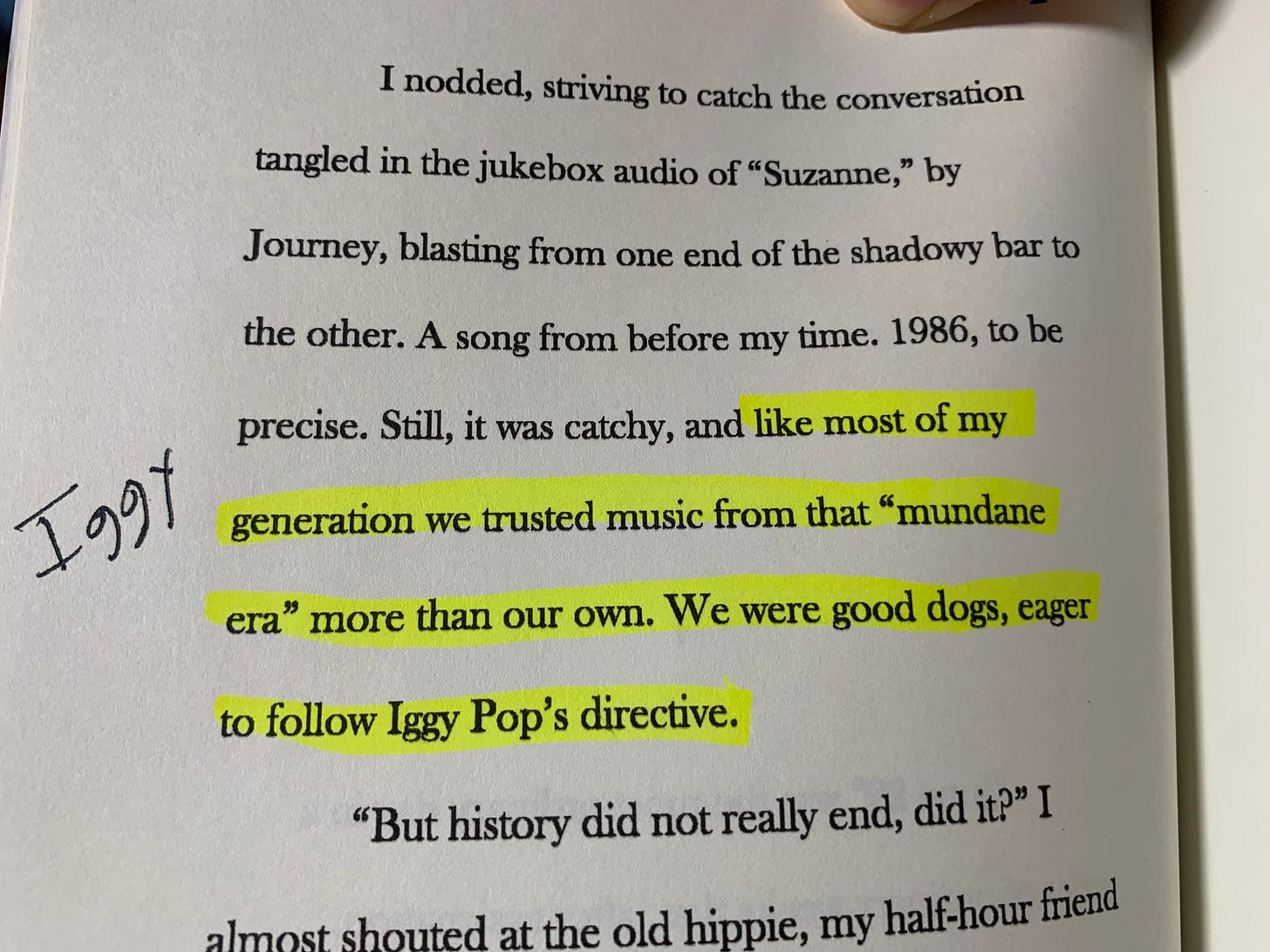Music injects warm nostalgic memories directly into the reader’s bloodstream, like literary-sonic heroin.
Felix Purat—an author who writes the Substack Timeless, with Felix Purat—agreed to read my punk-philosophical YA novel, The Crew, in exchange for my honest review of his recent book, Calm Before an Earthquake (260 pages, Swamp Rat Books).
Going into it I was nervous for all the obvious, non-specific reasons. (As I’m certain he was about my book, too.) Namely: Can this random dude I know a little from Substack actually write.
Well, he CAN, my friends. And well.
First off, I was shocked—and a little bewildered—by how many notable similarities there were between my book and his. Punk rock teens rebelling and getting into drugs and alcohol, philosophizing wildly, feeling suicidal, questioning essentially everything around them, desperately trying to fit in while simultaneously pretending to reject conformity. Not to mention the comfort and warmth I felt related to Purat’s novel’s location: The Bay Area, where I lived for a decade between 2008 and 2019.
Calm Before an Earthquake has little to work with in terms of traditional “plot.” This does not read like, say, a knockoff John Grisham or Stephen King novel, nor like a typical, cliché YA (Young Adult) novel with fast-paced movement from one scene to the next, moving us in a quick, easy arc from A to B to C. (That’s not to say that there is NO plot. There is. It’s just submissive to the more important richness of the novel: The characters; the content; the ideas.)
In other words, what we’ve got here is authentic literary fiction. My favorite, and really the favorite of anyone who likes to think.
The summary of the novel is as follows.
A twenties protagonist is on a drive north from the Bay Area to Oregon to start a PhD in Literature program at Oregon State. As he drives north he thinks about his life, past, present and future. In Arcata, Humboldt—also my old stomping grounds—the narrator stops in at a local bar (“Sidelines”) he has memories with. There, he encounters an “aged hippie” who buys the narrator beers while telling him a seemingly random story about three teenagers in June, 1989, Brad (cliché, typical conformist with an illuminating secret deep side), Adrianna (angry punk-nerd) and Felipe (Mexican kid who escaped the drug cartels who literally beheaded his parents).
The “earthquake” appears to be both the impending fall of communism in the Soviet Union, the terminus of the 1980s, and the end of a particular historical and cultural period in America and in fact the world. It also seems to mirror an interior [psychological] earthquake within three lonely teens trying to grasp the point of existence.
These three teens meet up in Sausalito (in the North Bay of the San Francisco Bay Area) at a graffiti-tattooed old log up a slight hill and basically smoke a shit-ton of pot and drink way, way too many bottles of Sam Adams beers. Along the way, they discuss various friends and enemies in and out of their respective social circles. Brad—whose heart has been broken by a popular, not-so-intelligent girl named Wendy—claims that out of total heartbreak he has decided to kill himself.
The story weaves in and out of the narrator interrupting the old hippie in the bar and having mini-insights, and the tale once more of the three teens. Music—punk rock bands like Green Day (then new, in 1989) and grunge bands like Nirvana (ditto) as well as classics like Dire Straits (the author’s favorite; he includes many lyric-quotes of the band), Journey, Joy Division, abound throughout the whole book. I liked this a lot. Music injects warm nostalgic memories directly into the reader’s bloodstream, like literary-sonic heroin.
Eventually, Brad leaves the group. The story is done in 3rd person omniscient; we move from Brad’s POV to Adrianna’s POV to Felipe’s POV and back again, helter-skelter. We follow Brad as he gets a ride from his buddy who was never supposed to have seen him hanging out with the weirdo (Felipe) and the nerd (Adrianna). Of course the cool buddy gives him shit and is suspicious and judgmental (par for the course for teens). We know Brad is getting a ride to the Golden Gate Bridge to kill himself. This is where a sense of “plot” really does enter the picture. The moment Brad is picked up by his buddy and leaves the group—and we know what his ultimate goal is—the tension is incredibly potent. I couldn’t stop turning the pages. What was going to happen? Would someone stop him? Would he die?
Later, after Brad’s dramatic exit, Wendy and a couple others show up to join the group with Adrianna and Felipe. Nasty words are exchanged between Adrianna and Wendy. Felipe and the dude who shows up get into it verbally as well, despite smoking pot from Felipe’s dad’s pipe he got from Jerry Garcia. (Long story.)
I’ll leave it there to avoid plot-spoilers. You’ll just have to read the book to find out.
The novel is not for the Woke or the faint of heart, or for anyone who goes purposefully looking for offense or impropriety. Words like “pussy,” casual references to "The AIDS,” phrases like “small tits,” and jokes about condoms and alimony, etc, abound. This is of course exactly as it should be. Over the past ten, fifteen years, something I’ve noticed in the book world is the loss of realism. This seems about right given the rise of fringe Left/Right ideology and the terrible tyranny of social media, where everyone is playing a social-online role. Many now pretend that teens are pure; that they don’t say nasty, racist, sexist, inappropriate things to each other all the damn time. (And that, to the extent they DO say these things it says something negative about their moral character.)
Of course they do. Always have. Always will. The best cultural achievements I can think of which show real teens being as they are: the film KIDS; the book The Basketball Diaries; The Catcher in the Rye; etc. Books that are fundamentally [culturally] accurate and honest. Let’s face it: Teens, especially boys, are not pure, not of life nor mouth nor behavior.
Growing up in the early to mid-1990s, we said “gay,” “fag,” “cunt,” “bitch,” “pussy,” and much, much more. We made fun of anyone who “looked or acted gay.” This wasn’t because we were homophobic; it’s because we were dumb, unformed teenage boys. It’s because we were insecure kids trying to belong. We followed group trends because that’s what kept us safe. What was true then is still true now. It’s how kids are. (Especially when teens get into groups; group psychology, as we now know thanks to social media, becomes grotesque very quickly.)
So, in other words: This novel felt real to me. The dialogue was solid. It felt believable. The voice was authoritative and honest. The characters were believable. The novel is at once both a tale of leaving one place for another—California for Oregon, in this case—and at the same time a tale of three teens attempting, however sloppily, to understand themselves and their minute roles in the world around them. Social cliques are explored in the book, which is another similarity to my YA novel. The brutal social sorting of teens in high school when the reality—at least the inner reality—is that there’s so much more nuance and complexity to all human beings, even Brad, who represents the classic cliché bro-type, the popular guy who wouldn’t be seen with “the nerds”…yet secretly is.
The writing on a line-by-line basis is often strikingly lush and beautiful. Purat knows how to write wonderfully; he can add in a lovely metaphor and also some luscious physical description all in one loaded line which nevertheless does not feel too weighed down with words. His prose is not overly verbose, nor too skimmed down, like trendy MFA writing nowadays where every single word is in danger of getting it’s head lopped off. (Pun intended.)
The book is also very funny. Humor abounds throughout the story. I found myself laughing one moment and thinking deeply the next, which is what a good novel should do. There’s a solid mix of emotional complexity with standard teen social negotiation. The friction of the opposing inner/outer lives of young people in late 20th century America.
Read Felix Purat’s book. BUY IT HERE.
And subscribe to his Substack.
You will regret neither. I promise.










Great review Michael. I am going to check out Felix's writing.
Thanks Michael! Fantastic review, and very perceptive too. Literary-sonic heroin: I dig it!